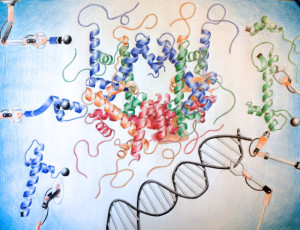
Artistic rendering by Ruixuan (Ryan) Yu
Background
The Ottesen Laboratory is interested in protein engineering as applied to solving biological problems and constructing new functional materials. Our projects are in three main areas: 1) Using the tools of chemical biology to understand histone modifications as the foundation of biological function; 2) Bridging the gap between synthetic proteins and biology; developing methods to introduce synthetic proteins into eukaryotic cells to study them in the cellular context, 3) Building new functional nanomaterials using the tools of biomolecular chemistry.
Chemical Tools for Histone Synthesis
In a eukaryotic organism, DNA is organized into nucleosomes by wrapping around cores of histone proteins like thread around a spool. These “spools” are then put away and organized into higher order structures. Small physical changes to these spools can set them apart, to identify them as the targets for biological activity such as activating a gene, or as a site of DNA repair. These changes are chemical modifications to histone proteins.
Our laboratory uses several different approaches to build histone proteins with distinct modification sets, then build them back into nucleosomes in order to understand how their functions have changed. More information about our synthetic toolkit can be found here: Chemical Tools for Histone Synthesis
We are particularly interested in understanding how chemical changes in the folded core of the nucleosome affects the inherent structure and dynamics of the nucleosome, and have a long-standing collaboration with the Poirier Laboratory in the Department of Physics. Please see our publication list for recent work in this area.
Crossing the Biological Barrier: Protein Chemistry in the Cell
With modern techniques in protein chemistry, we can treat proteins as large organic molecules with control down to the individual atom. However, we are typically limited to studying these elegant constructions in isolation in in vitro settings. The ultimate goal of a biomolecular chemist has to be bridging the gap between protein chemistry and the cellular environment. The Ottesen Laboratory has two ongoing projects in this area.
Engineered Hybrid Nanomaterials
Proteins are amazing materials with the ability to carry out very specific chemical reactions in a complex environment in response to cues from their surroundings. While protein engineers have long sought to capture this activity into human-designed systems, we have fallen short. Nucleic acids are simple materials and can be designed into dynamic programmable nanodevices, but they have minimal function. In collaboration with the Castro Laboratory in Mechanical and Aerospace Engineering, we are working to bridge this gap by designing protein-DNA hybrid nanomaterials with environmentally-sensitive function.
Collaborations
Information for Undergraduate Researchers